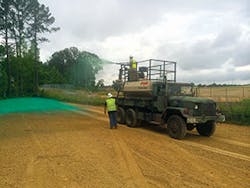Some years after the American Creosote plant in Louisville, MS, closed, residents grew concerned about the quality of their drinking water supply. Investigation revealed that erosion was allowing contaminants to seep through the soil. EPA ordered a Superfund cleanup of the land.
Damian McKay’s company, Green Way Erosion Control, of Wiggins, MS, has been doing erosion control work on the project. The crew started in fall 2013 and is finishing up the work this year.
“We were stabilizing the top surface and we did some site work,” says McKay. “A Florida company, Core Engineering, did the subsurface work. They built a wall underground, a 70-foot-deep trench all around the site, and pumped it full of cement so nothing could leak out.”
Like many major erosion control projects, this one was done in phases, including temporary and permanent seeding. Green Way planted 60 acres of temporary grass, using brown top millet, Bermuda grass, and Bahia grass. After the site was stabilized with permanent soils, the company applied hydromulch and Bahia grass and Bermuda grass seed on about 40 acres.
Part of the project involved stabilizing a 900-foot-long, 16-foot-wide ditch. McKay relied on the GreenArmor system, which combines Profile Products’ Flexterra flexible growth medium with Bonar’s Enkamat, a turf reinforcement mat (TRM).
“I put GreenArmor right up there with hard armor,” says McKay. “It’s one step below hard armor, but sometimes it does a better job than riprap and [other] hard armor.”
Green Way crew members also installed hard armor along a creek on the northwest side of the property where a creek bank had been washing out.
“We put hard armor, riprap, on the bank and pumped concrete in. Then we did basic seeding,” says McKay.
Maintenance work that will be done on the project will involve “some mowing and fixing washouts. We’ll probably do some Flexterra application,” says McKay.
He says the most challenging part of the American Creosote site project was getting the GreenArmor section exactly right. “You have to pay attention to your guide, put in enough staples, and get the mixture right,” he explains. “Enkamat is about one-half-inch thick. If the mixture is too thick, it could stick on top. It has to have enough liquid so it shoots down inside of the mat. You don’t want any air gaps.”
McKay also used GreenArmor on a project on the target berms of the bombing range at Camp Shelby, MS. He notes that while Enkamat can be used without the Flexterra, “in my opinion, you’re much better off using them together.”
American Creosote was a special project for McKay’s company because it was the first project involving the use of a drone. McKay sees drones as the next advance in erosion control work.
“There may be sediment in a creek. When you’re standing on the site you don’t see it, but a drone can fly up above before we start and show the sediment. We can do project updates and show a customer that the sediment was here before we began,” he says.
He notes that using a drone “gives you another perspective. You can do a video or still photos. It’s another tool in the toolbox. You can give clients a jump drive with the file [of their project] on it. Drones add value to our work.”
McKay sees a strong continuing need for erosion control work in the future. “I think with all the environmental concerns and regulations coming down from Washington that the erosion control business is here to stay.”
His only concern is with “engineers who spec material and don’t know what they’re spec’ing. It gives the whole industry a bad name when cheap materials and light spraying are done. That’s the old ‘spray and pray.’”
McKay says that when engineers tell him that hydroseeding doesn’t work, “I tell them that it does if you take soil tests, use the right mixture, the right application, and do it at the right time of year.”


